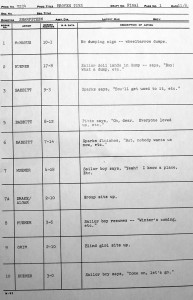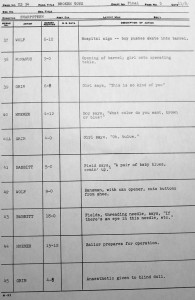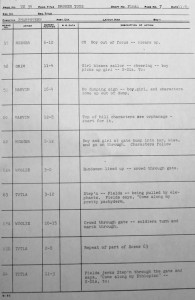
Our next Christmas-themed cartoon features a hidden Disney gem!
The story outline for the Silly Symphony Broken Toys was approved in May 1935. The cartoon was intended to follow Elmer Elephant and Three Little Wolves, two entries released around the early months of 1936. However, it was moved ahead of the other titles in the production schedule, for a Christmas release, by September. Surviving evidence from story sketches for Broken Toys indicate that Otto Englander — a former story artist for Ub Iwerks and Harman-Ising — and Larry Morey were the story directors. After the film’s December 14 release, the studio hadn’t produced many subsequent Christmas-related cartoons.
This Silly Symphony is built around celebrity caricatures, with a landfill of forgotten toys resembling Ned Sparks, Zasu Pitts, W.C. Fields, and Lincoln Perry, known as Stepin Fetchit in his “laziest man in the world” persona. They would all later be caricatured in 1938’s Mother Goose Goes Hollywood, the other Symphony based on lampooning movie stars.

Newer animators handled many scenes in Santa’s Workshop, but in the case of Broken Toys, specialized artists with East Coast animation studio backgrounds like Dick Huemer, Art Babbitt and Bill Tytla are thoroughly assigned by character. Huemer animates the key scenes of Jack Tar, the sailor boy; Babbitt handles the Ned Sparks, Zasu Pitts, W.C. Fields and the policeman toys, and Tytla animates the Stephin Fetchit marionette and Jemima rag doll. However, Babbitt animates the Jemima doll with W.C. Fields in scene 30, and the sailor boy with the steam shovel during the following scene. Furthermore, Tytla animates W.C. Fields and Stepin Fetchit being pulled by a stuffed elephant near the end of the cartoon.

With Snow White still under development, these animators (except Huemer) would later be assigned their own designated characters. Other animators credited in Broken Toys are John McManus, Leonard Sebring, Johnny Cannon, Bob Wickersham, Wolfgang “Woolie” Reitherman, Marvin Woodward, George Drake and James Algar (of which the draft credits one shared scene). Cy Young is responsible for some magnificent effects animation of a glove pumping oxygen during the operation sequence.
Myron “Grim” Natwick animates the blind girl doll, known as Dolly Delight. The dainty movements on the doll were unlike the banal representation of femininity in Disney’s earlier cartoons — specifically female characters fastened with an ornamental hair bow. Natwick’s perception in animating the female figure proved extensively useful for the lead character in Snow White. Natwick previously studied at the Chicago Art Institute and worked as an illustrator on sheet music, going into the animation business during the teens at Hearst’s International Film Service in New York. Though he also studied at New York’s National Academy of Design, he decided to go to Europe, where he attended the Vienna National Academy. After three years of intensive studying, Natwick felt his drawing had greatly improved.
 In the mid-‘20s, he animated for Bill Nolan, a colleague from IFS, at his Long Branch studio on the Krazy Kat series. Natwick later joined Max Fleischer’s studio around 1929 — animating on the early Talkartoons and Screen Songs — where he designed a caricature of Helen Kane as a canine cabaret singer, a character later known as Betty Boop. He left to work for Ub Iwerks’ studio in February 1931, whom he knew as the true creative force behind Disney’s cartoons. Natwick soon managed the daily operations there — including directorial duties on some of the films — while Iwerks focused on the technical aspects. At first, during his time at Fleischer’s, Walt Disney’s brother Roy was recruiting artists from the studio, but Natwick declined the invitation. When Natwick learned about Snow White, he decided to join, and was hired on November 12, 1934.
In the mid-‘20s, he animated for Bill Nolan, a colleague from IFS, at his Long Branch studio on the Krazy Kat series. Natwick later joined Max Fleischer’s studio around 1929 — animating on the early Talkartoons and Screen Songs — where he designed a caricature of Helen Kane as a canine cabaret singer, a character later known as Betty Boop. He left to work for Ub Iwerks’ studio in February 1931, whom he knew as the true creative force behind Disney’s cartoons. Natwick soon managed the daily operations there — including directorial duties on some of the films — while Iwerks focused on the technical aspects. At first, during his time at Fleischer’s, Walt Disney’s brother Roy was recruiting artists from the studio, but Natwick declined the invitation. When Natwick learned about Snow White, he decided to join, and was hired on November 12, 1934.
Intriguingly, Broken Toys parodies popular Hollywood stars of its era, but surviving documents denote a few actors found in contemporary films and radio programs.
Evidence for Disney’s voice recording sessions during this period is incomplete; hence, the voices for Ned Sparks, W.C. Fields, Stephen Fetchit and the Jemima doll are unknown. Child actor Tommy Bupp’s voice for the sailor doll offers an interesting parallel between the cartoon and one of its featured caricatures. Bupp had been a film extra in the early ‘30s; before Broken Toys went into production, he was featured in It’s A Gift (1934), starring W.C. Fields.
 Radio actress Martha Wentworth, known professionally as “the lady of a thousand voices,” provides her voice for the Zasu Pitts rag doll. Wentworth performed on occasion in an East Coast horror-fantasy radio series, The Witch’s Tale (1931-38), as the narrator Old Nancy, the Witch of Salem. She voiced in many cartoons, including the Captain’s wife in the MGM Captain and the Kids series and Jenny Wren in the Silly Symphony Who Killed Cock Robin? She continued to provide her voice for Disney into the ‘60s, including the eccentric Madam Mim in The Sword In The Stone. Silent comedy aficionados might appreciate Bud Duncan, who played opposite Lloyd Hamilton in Kalem’s “Ham and Bud” comedies made in the teens. He provides the voice of the policeman doll.
Radio actress Martha Wentworth, known professionally as “the lady of a thousand voices,” provides her voice for the Zasu Pitts rag doll. Wentworth performed on occasion in an East Coast horror-fantasy radio series, The Witch’s Tale (1931-38), as the narrator Old Nancy, the Witch of Salem. She voiced in many cartoons, including the Captain’s wife in the MGM Captain and the Kids series and Jenny Wren in the Silly Symphony Who Killed Cock Robin? She continued to provide her voice for Disney into the ‘60s, including the eccentric Madam Mim in The Sword In The Stone. Silent comedy aficionados might appreciate Bud Duncan, who played opposite Lloyd Hamilton in Kalem’s “Ham and Bud” comedies made in the teens. He provides the voice of the policeman doll.
Santa’s Workshop provided mostly incidental gags to entertain movie-going audiences accustomed to the Depression in effervescent Technicolor. The Depression is only evoked with the sewn patches on Santa’s sack of toys; the characters in Broken Toys are victims of it. Seldom discussed in the echelon of the Silly Symphonies, Broken Toys is an example of how the studio vastly developed its storytelling, mood and color at the studio — especially during the gentle, but effectively intense scenes of Dolly Delight’s operation. “We’re Gonna Get Out of the Dumps” certainly isn’t as memorable as the songs which came after the wake of “Who’s Afraid of the Big Bad Wolf?” as a veritable tonic for Depression-era audiences. However, the song itself provides an element in the demoralized toys’ self-reliance and dependence on each other to rehabilitate themselves, even if the song title is maybe too blatant and obvious in context.
Get yourselves out of the dumps and enjoy this week’s breakdown video!










(Thanks to J.B. Kaufman, Michael Barrier, Keith Scott and Frank Young for their help.)


 DEVON BAXTER is a film restoration artist, video editor, and animation researcher/writer currently residing in Pennsylvania. He also hosts a
DEVON BAXTER is a film restoration artist, video editor, and animation researcher/writer currently residing in Pennsylvania. He also hosts a 





















































































Babbitt did a great job on Zasu Pitts. He really caught her mannerisms. Huemor’s animation is always charming.
Thanks for taking the extra trouble to identify who animated which part of which scene when more than one animator was involved. Aside from the unfortunate stereotypes, which couldn’t be removed without hurting the whole film, it’s remarkably strong in character development. There is at least a sense of community if not equality among the characters. The colors are particularly rich. And I had forgotten that it had a Christmas finale.
This is before Disney had developed an unmistakably Disney “house style”. I sense a strong Fleischer influence in some of the characters and scenes–although the masterful cohesiveness of the piece marks it as a Disney effort. I find it somewhat reminiscent of both “The Cookie Carnival” and “Red Hot Chocolate Soldiers” (a Disney cartoon inserted into MGM’s 1934 extravaganza “Hollywood Party”). The bit with Fields threading the needle would later be used to great comic effect in Disney’s “Cinderella.”
Thanks for a fascinating and timely post!
Another one of my favorite Christmas cartoons. And indeed it’s a rare gem. This Silly Symphony rarely gets any air time on tv. I’ve seen it only a couple of times on tv, the first time was back in the 1970’s and second time a few years ago even though several of the scenes were edited out by politically correct censorship. I wonder if Broken Toys inspired the Disney series Doc McStuffins on how toys still can be useful after being repaired?
Why do people always refer to Stepin Fetchit as doing his laziest man in the world “persona”? Is this so we won’t confuse it with his famous portrayal of Ivanov or his equally notable performance as Willy Loman? Lincoln Theodore Monroe’s stage name was “Step And Fetch It”. He was famous for that act alone. He was the first black actor to become a millionaire. Why don’t you refer to William Claude Dukenfield’s “WC Fields persona” or Eliza Susan Pitts “Zasu Pitts persona”? Does a black actor have to play Malcom X before you can admit they were typecast, or do they just have to be white?
One would assume that Mr. Perry did not do the “Fetchit” business in his personal or intimate life. Thus, it was a persona–an adopted set of actions and mannerisms that were only in use when he was “on.” Many comedians–Harold Lloyd, the Marx Brothers, Buster Keaton, Chaplin, Laurel and Hardy, et al–relied on personas that did not reflect their behavior and actions away from the public.
This was one of those cartoons I remember seeing as a kid on “Mickey Mouse Club” (in early 60s syndication) and not seeing again for decades. I always recalled the operation pretty clearly; was surprised to see how closely I remembered it. Bless you, home video.
Note that it never explicitly references Christmas; it’s just assumed from the combination of toys and winter. There were at least two more Christmas-themed cartoons after this, both featuring Chip and Dale: “Pluto’s Chirstmas Tree” with bit parts for the rest of the gang and “Toy Tinkers” with Donald Duck. A few more had snowy settings that fit nicely on holiday bills: “The Hockey Champ”, “Donald’s Snow Fight” and “Pluto’s Sweater”.
Well, it does play Christmas music.
The voice of the Aunt Jemima doll sounds like Lillian Randolph
It’s not clear, but I think the orphanage is named “St Nick’s”.
“Silent comedy aficionados might appreciate Bud Duncan, who played opposite Lloyd Hamilton in Kalem’s “Ham and Bud” comedies made in the teens. He provides the voice of the policeman doll.”
That’s a funny combination of roles. So sometimes you can see but not hear him, and sometimes you can hear but not see him.
According to Natwick’s recollections at the below link, he went to work for Fleischer in or just after February 1930, shortly after Dick Huemer’s departure.
http://huemer.com/animate2.htm